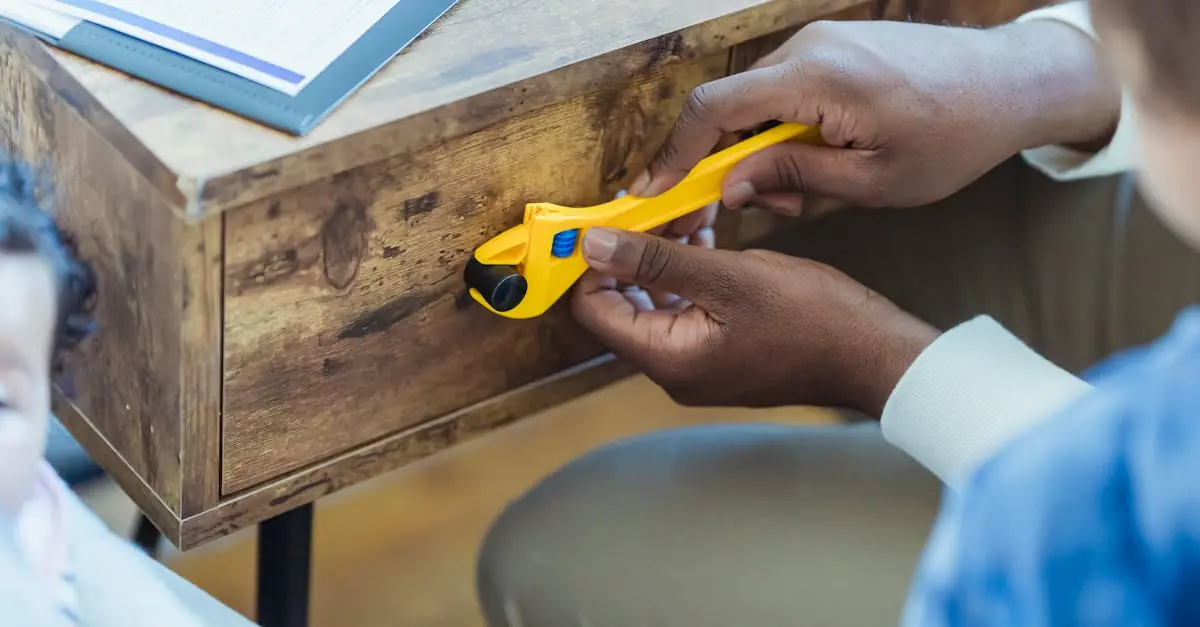Drawer glides are the unsung heroes of every kitchen and office, silently supporting countless snacks and paperwork. Yet when they start to squeak, stick, or worse—refuse to budge—it’s like a soap opera where the drama just won’t end. Fear not! Drawer glide repair is simpler than it sounds and can save you from a life of wrestling with stubborn drawers.
Table of Contents
ToggleUnderstanding Drawer Glides
Drawer glides play a crucial role in the smooth operation of drawers, enhancing usability in kitchens and offices. When functioning properly, these components ensure hassle-free access to stored items.
Types of Drawer Glides
Several types of drawer glides exist, including ball-bearing slides, roller slides, and wooden slides. Ball-bearing slides provide a smooth, silent operation ideal for heavy loads. Roller slides, often made from plastic or metal, are easy to install and suitable for lighter drawers. Wooden slides offer a traditional look, providing a strong, stable option. Each type has its advantages, making it essential to choose one that suits specific drawer needs.
Importance of Proper Functionality
Proper functionality of drawer glides is vital for longevity and ease of use. Smoothly operating glides prevent damage to both drawers and cabinets. Issues such as sticking or squeaking can lead to frustration, making it difficult to access items. Ensuring glides function optimally also promotes safety, as malfunctioning drawers can pose risks. Regular maintenance, including cleaning and lubrication, keeps drawer operations seamless and efficient.
Common Issues with Drawer Glides
Drawer glides can experience various problems that impact functionality. Identifying these issues early leads to smoother repairs.
Signs of Damage
Squeaking noises during movement indicate potential damage to the glides. Sticking or jamming drawers suggest misalignment or wear. Bent or broken components can lead to drawers not opening or closing properly. Visible wear, such as cracks or chips, shows the need for replacement. It’s important to inspect the glides regularly to avoid further complications.
Causes of Drawer Glide Failure
Improper installation often leads to glide failure. Excessive weight in drawers can strain the glides beyond their limits. Lack of lubrication causes friction, which accelerates wear and tear over time. Water damage may warp materials, leading to misalignment. Dust and debris accumulation can obstruct smooth operation. Understanding these causes helps maintain drawer functionality effectively.
Drawer Glide Repair Process
Repairing drawer glides ensures smooth operation and functionality. Follow the outlined steps for effective repair.
Tools Needed for Repair
Essential tools simplify the repair process. A screwdriver accommodates various screw types. Pliers help in gripping and adjusting components. Lubricant like silicone spray reduces friction. A level ensures the drawer aligns properly. Measuring tape assists in precise adjustments. Additional materials such as wood glue or replacement glide kits fix damaged slides effectively.
Step-by-Step Repair Guide
Begin by removing the drawer from the frame. Inspect the glide components for any visible damage. Next, check the screws; tighten any that may be loose. If necessary, replace damaged glides or install new ones. Apply lubricant on the glide mechanisms for smooth operation. Reposition the drawer and test its movement. Align it properly with the cabinet for best results. Finally, perform a functionality test to ensure the drawer operates seamlessly.
Maintaining Drawer Glides
Maintaining drawer glides ensures smooth operation and extends the lifespan of drawers. Regular care prevents common issues and enhances usability.
Tips for Preventative Maintenance
Keep glides clean by removing dust and debris that can cause friction. Lubricate them every few months with a silicone spray or appropriate lubricant to reduce noise and enhance movement. Inspect glides for visible signs of wear and tear, such as cracks or rust. Tighten any loose screws to prevent misalignment that could affect drawer function. Ensure proper weight distribution within drawers to avoid stressing glides beyond their limits.
When to Consider Replacement
Consider replacement when glides show significant wear, visible cracks, or bending. Notice excessive noise during operation as a sign of potential failure. Drawers that stick frequently indicate glide malfunction. If lubrication doesn’t improve performance, replacement is likely necessary. Assess whether the glides can be repaired or are too damaged to restore functionality effectively. Ultimately, prioritizing replacements promptly prevents further drawer issues and ensures smooth operation.
Repairing drawer glides can transform frustrating experiences into smooth operations. By understanding the common issues and employing the right techniques, anyone can restore functionality to their drawers. Regular maintenance plays a vital role in preventing future problems and extending the lifespan of drawer glides.
When faced with squeaking or sticking drawers, it’s essential to assess whether a simple repair will suffice or if replacement is necessary. With the right tools and a bit of patience, tackling drawer glide repairs becomes a manageable task. Embracing these practices ensures that drawers remain a reliable and efficient part of any kitchen or office space.








